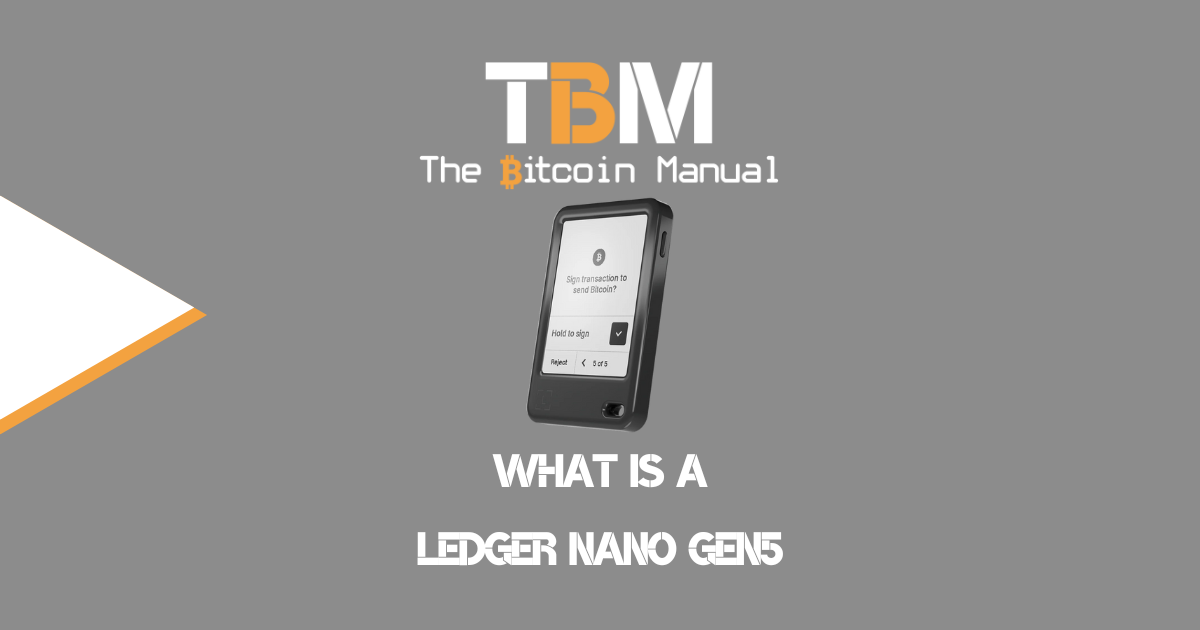The hardware wallet market has evolved dramatically since the first Ledger Nano devices emerged nearly a decade ago. Ledger had a first-mover advantage, and the Nano S brand and visual aesthetic were nearly synonymous with self-custody, but as competition emerged and Ledger faced its own share of drama —hacks and questions over access to private keys —it pushed some users away.
Today, there are devices for every class of people: the privacy-focused hodler, the budget hodler, and even the delusional altcoiner.
While the Nano S still works, it has been discontinued, and future support isn’t looking likely, as Ledger follows the Apple model of encouraging users to upgrade their self-custody with its new product ranges.
With the launch of the Ledger Nano Gen5, announced at Ledger Op3n 2025 and scheduled for shipping at the end of October 2025, the company is attempting to bring touchscreen technology to a more accessible price point while maintaining its security credentials.
But how does this device stack up from a Bitcoin-only perspective, and should Bitcoin holders consider it over purpose-built Bitcoin wallets?
The End of an Era: Ledger’s Classic Nano Line
Before diving into the Gen5, it’s worth acknowledging what we’re leaving behind. The Ledger Nano series has been the backbone of hardware wallet adoption for years. The original Ledger Nano S, launched in 2016, became the best-selling crypto hardware wallet of all time, introducing the USB-stick form factor with an OLED Secure Screen driven by a Secure Element chip. Its successors—the Ledger Nano X (2019) with Bluetooth connectivity and the Ledger Nano S Plus (2022) with increased storage—cemented Ledger’s position in the market.
With the introduction of the Nano Gen5, Ledger is effectively sunsetting the button-based navigation interface that defined the classic Nano line. While the Nano S Plus ($79) and Nano X ($149) remain available, they represent the old guard. The Gen5, alongside the premium Ledger Flex ($249) and Ledger Stax ($399), signals Ledger’s commitment to touchscreen-based interaction for all future devices.
For long-time Ledger users, the company is offering a 20% upgrade discount for verified Nano S owners transitioning to newer models.
What Is the Ledger Nano Gen5?
The Ledger Nano Gen5 is Ledger’s latest hardware wallet, priced at $179 and positioned as the “affordable touchscreen” option in their lineup. It abandons the classic USB-stick design for a more contemporary form factor featuring:
- 2.8-inch E Ink monochrome touchscreen – Similar to the Ledger Flex but with a smaller display
- Triple connectivity – USB-C, Bluetooth, and NFC
- Dual Secure Element architecture – Running Ledger OS for key protection
- Ledger Recovery Key – An optional encrypted backup solution included in the box
- Clear Signing support – Human-readable transaction verification
- Transaction Check – Additional security layer for detecting malicious transactions
- Customizable design – Optional decorative badges including artwork by Susan Kare (the original Apple Macintosh icon designer)
The device is specifically designed to integrate seamlessly with Ledger’s all-in-one Ledger Wallet app, which serves as the interface for buying, selling, swapping, staking, and managing digital assets.
Understanding Clear Signing: Why It Matters
One of the Ledger Nano Gen5’s flagship features is “Clear Signing,” and understanding this concept is crucial for evaluating any modern hardware wallet.
What is Clear Signing?
Clear Signing refers to the ability of a hardware wallet to display transaction details in human-readable format directly on the device’s secure screen, rather than showing raw hexadecimal data or cryptographic hashes that users must trust blindly.
Why It’s Important:
In the early days of Bitcoin, transactions were relatively simple: send X amount to Y address. Modern blockchain interactions, however, have become exponentially more complex, especially with smart contracts. Even Bitcoin now supports more sophisticated transaction types with Taproot and multi-signature schemes.
Without Clear Signing:
- You might see:
0x4a5b...c3d2(cryptographic hash) - You’re essentially signing blind, trusting that the software wallet is accurately representing the transaction
With Clear Signing:
- You see: “Send 0.05 BTC to bc1q… (your confirmed contact)”
- You can verify every detail before approving
For Bitcoin users, Clear Signing becomes particularly important when:
- Executing multi-signature transactions
- Using Bitcoin DeFi protocols (like Lightning Network)
- Interacting with new address formats (Taproot addresses)
- Verifying change addresses to prevent address substitution attacks
The Ledger Gen5’s 2.8-inch touchscreen provides substantially more real estate than the 128×64 pixel button-based displays of older Ledger devices, making Clear Signing actually practical rather than merely theoretical.
Hardware Wallet Comparison: Bitcoin Perspective
When evaluating the Ledger Nano Gen5 from a Bitcoin-only standpoint, it’s essential to compare it against both multi-currency competitors and dedicated Bitcoin hardware wallets in a similar price range.
| Feature | Ledger Nano Gen5 | Coldcard Q | BitBox02 | Trezor Safe 3 | Blockstream Jade |
|---|---|---|---|---|---|
| Price | $179 | ~$299 | $130 | $79 | $61 |
| Display | 2.8″ E Ink touchscreen | Large LCD + QWERTY keyboard | No touchscreen (buttons) | Color touchscreen | 1.14″ color screen |
| Bitcoin Only | No (5,500+ coins) | Yes | Yes | No (multi-currency) | Primarily (Bitcoin + Liquid) |
| Open Source | Partially (apps only) | Fully | Fully | Fully | Fully |
| Secure Element | Yes (Dual) | Yes (Dual) | Yes | Yes | No (uses phone as SE) |
| Air-Gapped | No | Yes (SD card/QR) | No | No | Optional (QR codes) |
| Clear Signing | Yes | Yes | Partial | Yes | Limited |
| Connectivity | USB-C, Bluetooth, NFC | USB-C, NFC, SD, QR | USB-C | USB-C | Bluetooth, USB-C |
| Power | Rechargeable | AAA batteries or USB-C | USB powered | Rechargeable | Rechargeable |
| Backup Method | Recovery Key + Seed phrase | MicroSD + Seed phrase | MicroSD + Seed phrase | Seed phrase | Seed phrase |
| Multisig | Yes (via apps) | Advanced native | Native | Yes | Yes |
| Firmware | Closed source | Open source | Open source | Open source | Open source |
| Best For | Multi-currency users | Bitcoin maximalists | Bitcoin beginners | Budget users | Privacy-focused users |
Key Observations about Ledger Nano Gen 5:
Ledger’s Strengths:
- Most polished user interface and companion app ecosystem
- Largest screen among affordable options
- Excellent build quality and industrial design
- Strong track record (no successful hardware attacks)
- Integrated ecosystem with Ledger Wallet app
Ledger’s Weaknesses from a Bitcoin Perspective:
- Not open source firmware (major concern for sovereignty-focused Bitcoiners)
- Supports thousands of altcoins (increased attack surface)
- Cloud-based recovery options (privacy concerns)
- Cannot operate fully air-gapped
- Past controversies around data breaches (customer data, not funds)
- Bluetooth/NFC connectivity creates potential attack vectors
Why Bitcoin-Only Wallets Remain Superior?
For serious Bitcoin holders, dedicated Bitcoin-only hardware wallets like the Coldcard Q or BitBox02 Bitcoin-Only edition offer significant advantages:
1. Reduced Attack Surface
Every additional cryptocurrency supported requires additional code, libraries, and complexity. Bitcoin-only firmware can be orders of magnitude smaller and simpler, with fewer potential vulnerabilities. When a device supports 5,500+ cryptocurrencies like the Ledger Gen5, each additional protocol introduces potential security risks.
2. Philosophical Alignment
Bitcoin-only wallets are built by teams deeply committed to Bitcoin’s principles of decentralisation, sovereignty, and sound money. Their entire business model depends on Bitcoin’s success, ensuring aligned incentives with users.
3. True Air-Gap Capabilities
Devices like the Coldcard Q can operate completely offline, signing transactions via QR codes or microSD cards without ever connecting to a networked device. This eliminates entire categories of attacks related to compromised USB connections, malicious Bluetooth pairing, or supply chain firmware injection.
4. Open Source Transparency
Bitcoin-only wallets typically embrace full transparency with open-source hardware and firmware designs. Anyone can audit the code, verify builds are reproducible, and ensure there are no backdoors. Ledger’s closed-source firmware requires trusting the company’s security practices.
5. Advanced Bitcoin-Specific Features
Purpose-built Bitcoin wallets often include features specifically designed for Bitcoin power users:
- Advanced multisig configurations (2-of-3, 3-of-5, etc.)
- Duress wallets (decoy wallets under different PINs)
- Coin control and UTXO management
- Native PSBTs (Partially Signed Bitcoin Transactions)
- Dice-roll entropy for seed generation
- Anti-phishing security measures
6. No Shitcoin Distractions
Bitcoin-only wallets force discipline. There’s no temptation to “diversify” into speculative altcoins or yield-farming schemes. The device does one thing and does it exceptionally well: securing Bitcoin.
The Pragmatic Reality: Self-Custody Over Perfection
That said, there’s an important caveat: self-custody with an imperfect tool is infinitely better than no self-custody at all.
If you find yourself in a situation where:
- Bitcoin-only hardware wallets are unavailable in your country due to import restrictions
- You need a device immediately, and Ledger is the only option locally available
- You’re transitioning from exchange custody and the Ledger is accessible right now
- You lack the technical confidence to set up more complex Bitcoin-only solutions
…then the Ledger Nano Gen5 is still a viable choice.
Here’s why:
The Exchange Custody Alternative Is Worse
Keeping Bitcoin on centralised exchanges means:
- You don’t actually own the Bitcoin (“not your keys, not your coins”)
- Exchange insolvency risk (Mt. Gox, FTX, Celsius, etc.)
- Government seizure risk
- Account freezing based on arbitrary rules
- Privacy violations through KYC data leaks
- No ability to verify transactions on-chain
A Ledger wallet, despite its imperfections, gives you:
- Actual ownership of your private keys
- Control over when and how you transact
- Protection against exchange hacks
- Ability to verify and sign transactions locally
Ledger’s Security Track Record
To Ledger’s credit, no Ledger device has ever been successfully hacked to extract private keys from the Secure Element. While the company has suffered customer database breaches (exposing names and addresses of buyers), the actual hardware security has remained robust.
The Secure Element chips (EAL5+ certified) provide strong protection against physical attacks, side-channel attacks, and fault injection attacks. The company has a responsible disclosure program and works with security researchers to address vulnerabilities.
Migration Path
Using a Ledger as a temporary solution while you source a proper Bitcoin-only wallet is perfectly reasonable. You can:
- Set up the Ledger Nano Gen5 immediately
- Move your Bitcoin off exchanges into self-custody
- Order a Bitcoin-only device (Coldcard, BitBox02, etc.)
- When it arrives, generate a new seed on the Bitcoin-only device
- Transfer your Bitcoin from Ledger to the new device
- Wipe the Ledger or keep it as a backup/travel wallet
Self-Custody Recommendations
If You’re a Bitcoin Maximalist:
Choose: Coldcard Q, BitBox02 Bitcoin-Only, or Blockstream Jade or Jade Plus
These devices align with Bitcoin philosophy, offer superior security through open-source transparency, and provide features specifically designed for serious Bitcoin holders.
If You’re New to Self-Custody:
Consider: Ledger Nano Gen5 or Trezor Safe 3
The user experience and ecosystem support will make your transition smoother. You can always migrate to a Bitcoin-only wallet as you become more knowledgeable.
If You’re Geographically Limited:
Use: Whatever hardware wallet you can legally and practically obtain
Self-custody with a Ledger is better than exchange custody. Period.
If You Hold Multiple Cryptocurrencies:
Acknowledge: You’re not reading this from a Bitcoin-only perspective anyway
But seriously, if you genuinely need multi-currency support for legitimate reasons (not speculation), the Ledger Gen5 offers excellent UX across many protocols, especially for those still tied to the stablecoin standard.
Self-custody is better than no custody
The Ledger Nano Gen5 represents a significant upgrade in usability and screen real estate compared to classic Ledger devices. The touchscreen interface, Clear Signing capability, and integration with the Ledger Wallet ecosystem make it one of the most polished hardware wallet experiences available.
However, from a Bitcoin-first perspective, dedicated Bitcoin-only wallets remain the superior choice for anyone serious about long-term Bitcoin security and sovereignty. The reduced attack surface, open-source transparency, air-gap capabilities, and philosophical alignment with Bitcoin values make devices like the Coldcard Q or BitBox02 Bitcoin-Only edition the gold standard.
That said, reality is messy. If the choice is between:
- Keeping your Bitcoin on an exchange
- Using a Ledger Nano Gen5 for immediate self-custody
Choose option two without hesitation. The perfect is the enemy of the good, and self-custody—even with an imperfect tool—is exponentially better than trusting centralised custodians with your Bitcoin.
The Ledger Nano Gen5 is a competent hardware wallet. It’s just not the wallet that serious Bitcoiners would choose if they had access to better alternatives. Use it as a stepping stone to sovereignty, not as the final destination.
Frequently Asked Questions
While you can choose to only install the Bitcoin app and ignore other cryptocurrencies, the device firmware still includes code for all supported assets. You cannot reduce it to Bitcoin-only firmware like you can with a Coldcard.
The Recovery Key is an optional backup solution that encrypts your seed with a PIN. From a Bitcoin maximalist perspective, any additional complexity or proprietary backup method is concerning. Traditional seed phrase backups (ideally on metal) remain the gold standard.
For maximum security, disable Bluetooth and use USB-C only. While Ledger claims their Bluetooth implementation is secure, it introduces an additional attack surface that’s unnecessary for most users.
No, Ledger’s firmware is closed source. You must trust Ledger’s security practices. This is a fundamental philosophical difference from Bitcoin-only wallets with reproducible builds.
Ledger has consistently supported Bitcoin protocol upgrades (SegWit, Taproot, etc.). However, their attention is divided across thousands of cryptocurrencies, whereas Bitcoin-only wallet developers focus exclusively on Bitcoin improvements.
DYOR before you pick our HODL method
If you’d like to learn more about Ledger’s latest signing device, use this article as a jumping-off point and continue your own research by checking out the links below.




